Introduction
Engaging an Outsource Chief Technology Officer (CTO) can provide businesses with strategic technical expertise and guidance without the commitment of a full-time executive. These part-time or project-based collaborations bring extensive experience to the table, allowing Outsource CTOs to craft and implement custom technology strategies that drive growth. With knowledge spanning various sectors, these specialists can identify impactful tools, such as Django and Tailwind, and utilize SEO to optimize content and boost targeted traffic.
As the corporate technological landscape evolves, CTOs must go beyond traditional tech oversight and deliver efficient user experiences while overcoming scale-related challenges. Outsourcing a CTO offers benefits such as cost savings, access to top talent, flexibility, and an objective perspective. However, careful consideration should be given to clear communication, proper due diligence, cultural differences, and best practices for successful collaborations.
Hiring the right Outsource CTO involves defining requirements, researching and evaluating candidates, conducting thorough interviews, and agreeing on terms and expectations. A strong partnership with an Outsource CTO can propel a business forward, driving innovation and growth in today's dynamic tech-driven marketplace.
What is an Outsource CTO?
Engaging an Outsource Chief Technology Officer (CTO) opens a world of strategic technical prowess and guidance for businesses looking to navigate the intricacies of technology-driven markets without the commitment to a full-time executive. Utilizing part-time or project-based collaborations, Outsource CTOs bring a wealth of experience to the table, driving growth by crafting and implementing technology strategies that are custom-fitted to an organization's unique needs. Equipped with knowledge that spans across varied sectors, these specialists can pinpoint the most impactful tools, such as Django, Tailwind, or HTMX, and harness the power of SEO to outmaneuver competition, optimizing content to reach uncharted heights in targeted traffic results.
The evolving corporate technological landscape demands more from a CTO than traditional oversight of tech operations; it's about delivering a seamless, efficient user experience, all while overcoming scale-related challenges, as exemplified by Holiday Extras, Europe's leading travel extras provider. Here, aligning a singular marketing team's efforts across multiple languages and bolstering data fluency epitomize the CTO's expanding scope. Moreover, at companies like Delivery Hero, an unprecedented global workforce encounters logistical hurdles, which the savvy CTO must address to ensure seamless access to vital tools and resources.
With the advent of 2024 on the horizon, the bullish sentiment in software growth spotlights a dynamic market shift, fundamentally influenced by cutting-edge AI and startup ecosystem vibrancy. This is a prime time for forward-looking CTOs to join forces with enterprises to rethink and revitalize technology infrastructures, transcending mere management to become key players in strategic decision-making, fostering innovation, and leveraging emerging tech trends as cornerstones for competitive advantage.
Outsource CTOs are pivotal in addressing the blank whiteboard problem, maneuvering with skill and insight to design foundational systems from the ground up. Their capability to navigate past the prior experience problem, frequently encountered by engineers reverting to familiar processes and technologies, distinguishes them as instrumental in nurturing startups aiming for transformation. With an eye towards fine-tuning the balance between competing requirements and informed decision-making, an Outsource CTO's contribution is undeniably strategic, magnifying a business's technological posture and trajectory.
Benefits of Outsourcing a CTO
The evolving role of the Chief Technology Officer (CTO) significantly impacts how businesses approach their technology needs, especially when considering outsourcing this vital role. With the responsibilities of CTOs broadening to encompass strategic and innovative pursuits beyond mere tech management, companies are recognizing the advantages of outsourcing a CTO to drive forward their technology initiatives. This strategic move allows for leveraging expertise in developing systems from scratch—a task that can be daunting for engineers unaccustomed to creating without a pre-existing framework.
Outsourcing a CTO can bring a competitive edge by utilizing a global expert well-versed in modern tech stacks, including Artificial Intelligence (AI), Machine Learning, and cloud computing, aligning with the need for meticulous decisions balancing competing requirements. Offshore development, a scheme where businesses engage software development teams from across the globe, further highlights the trend towards optimizing resources and tapping into a wider talent pool to escalate innovation and strategic planning. With offshore development's promise of cost reduction and access to diverse expertise, the previous success stories, like that of engineers learning to code in Australia scaling up to Silicon Valley, serve as inspirational case studies.
Streamlining operations through outsourcing ensures a consistent user experience by identifying competitors' successful strategies and emulating them elegantly using efficient technical frameworks and digital marketing such as SEO to improve visibility conspicuously. Hence, the outsourcing of a CTO encapsulates a multi-faceted approach to technological leadership, encompassing the creation and optimization of systems, strategic decision-making, and global talent utilization to foster innovation and growth in today's dynamic tech landscape.
Access to Top Talent
Outsourcing a Chief Technology Officer (CTO) equips businesses with a strategic advantage by bringing on board professionals who not only possess exceptional technological acumen but also understand how to navigate the complexities of innovation and leadership. These outsourced CTOs come with a wealth of experience that often aligns with industry best practices. They can craft and steer technology strategies that are tailor-made to elevate a business's growth trajectory.
With the role of CTOs evolving considerably as we march into 2024, companies recognize that these tech maestros are instrumental in scaling industries globally. They resonate with the ethos that 'technical' is not merely synonymous with technology but embodies a profound understanding of various facets, including banking and payment systems, that are central to a business. Moreover, the trend of leveraging offshore development expands a company's horizons, providing access to a global pool of talent and enabling cost-effective operations while diligently addressing the challenges startups face when dealing with technology choices and infrastructure development.
Therefore, a formidable amalgamation of leadership, deep industry insight, and technical expertise makes outsourced CTOs invaluable in today's tech-driven marketplace.
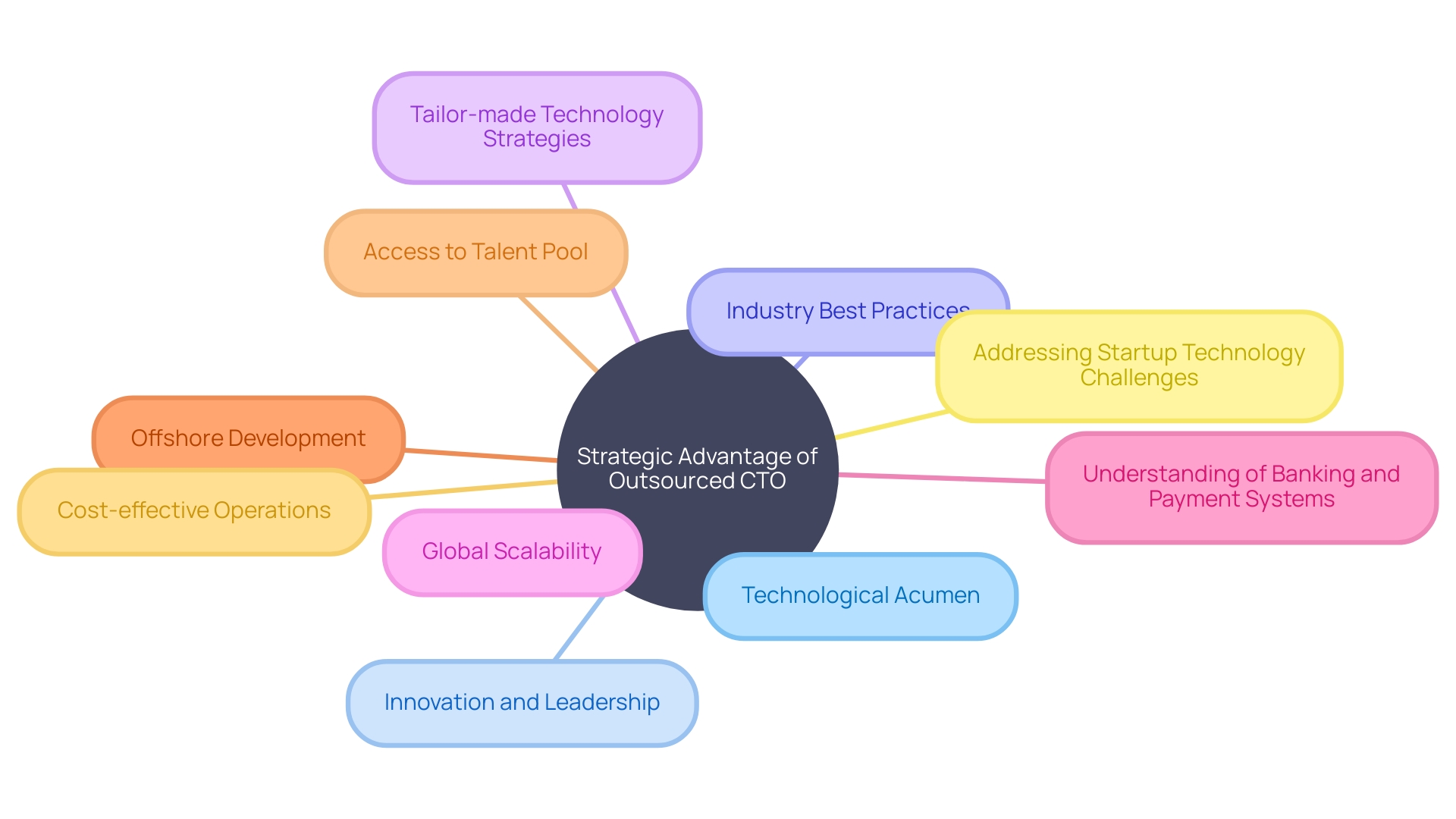
Cost Savings
Engaging a part-time Outsource CTO can indeed offer cost efficiencies, yet it's essential to look beyond simple expense reduction. When we delve into the complexities of software development, we encounter a myriad of factors contributing to the true cost. The initial savings from reduced hourly rates may seem compelling, especially when tapping into a global pool of talent from regions where labor costs are more economical.
However, long-term costs accrue from the need for meticulous communication, adept management, and thorough approvals, which can eclipse the initial outlay.
Reflecting on Gusto co-founder Eddie Kim's insights, we must consider that maintenance typically accounts for the majority of software development expenses, potentially up to five times the cost of the initial build. Therefore, achieving cost savings without sacrificing quality requires a balanced approach: ensuring the Outsource CTO implements rigorous documentation practices, integrates automated testing, and fosters straightforward knowledge transfer.
As we edge towards 2024, the role of a CTO pivots away from a purely operational stance towards a strategic linchpin within the organization, tasked with harnessing innovation and leveraging emerging technologies. Ostensibly, the allure of an Outsource CTO lies in financial prudence, but the broader implications encompass the creation of stable, quality software that aligns with business objectives and minimizes long-term maintenance costs. These factors form a fuller picture of software development costs, underscoring the importance of quality and strategic fit when considering outsourcing this critical role.
Flexibility
Engaging an Outsource CTO can be a strategic move for businesses looking to navigate the complexities of technology management without the overhead of a full-time executive. This modern approach allows companies to harness specialized expertise only when needed, particularly during project-specific demands or peak business periods. For instance, an Outsource CTO proficient in React development can bolster the creation of web applications that drive superior user experiences, affording your internal team the luxury to concentrate on delivering top-tier projects efficiently.
Such flexibility in scaling technical know-how aligns seamlessly with changing business landscapes, permitting access to an array of skillsets—from communication to project management—without a protracted engagement.
With the evolving role of CTOs to encompass strategic initiatives alongside tech management, the appeal of an Outsource CTO becomes more pronounced. As technology trends like AI and cloud computing reshape business dynamics, the ability to pivot and adopt these innovations is crucial. Statistics show that offshore development offers attractive cost benefits by leveraging global talent pools in countries with competitive labor costs.
This observation holds especially true for small online businesses in need of a robust technology strategy without incurring exorbitant costs or ceding control.
A Co-Sourcing approach integrates outsourcing with internal efforts, highlighting its growing popularity in tech companies for functions such as customer support. Reflecting on the case of Sunday, where the CTO role was pivotal in transitioning from an experiment to a product deliverable across multiple countries, businesses can replicate this success by embracing the flexibility offered by Outsource CTOs. This strategy resonates with industry tendencies where CTOs are elevated to strategic decision-makers, monitoring tech trends and innovating within their domain.
It delivers a competitive edge through cost-effectiveness and access to a diverse set of skills, ensuring that companies adapt quickly to the ever-changing tech landscape.
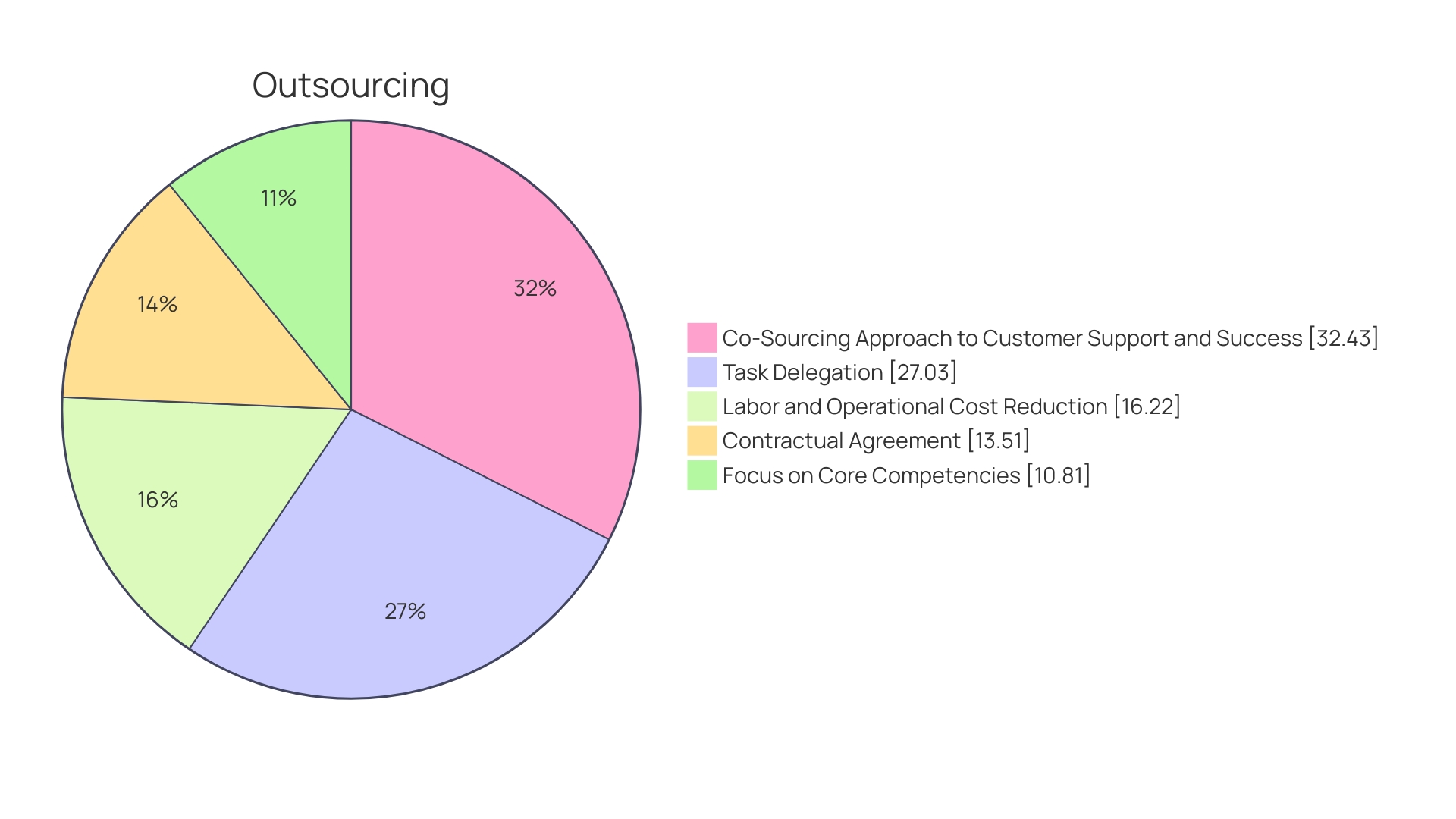
Objective Perspective
In the domain of technical leadership, the contribution of an external Chief Technology Officer (CTO) can be invaluable. Freed from the influence of internal dynamics and pressures, an outsourced CTO assesses the technological landscape with a clear lens, delivering impartial insights that catalyze innovation and catalyze growth. This neutral vantage point is similar to how a fresh set of eyes can spot opportunities that insiders might overlook, as seen in the case of Prashant Varanasi, who pivoted from learning basic coding in Australia to shaping tech solutions in Silicon Valley.
Indeed, as the digital realm becomes intrinsically linked with every business function, the expectations from technological directors like CTOs have escalated. Whether it's an employee in marketing depending on data analytics tools or a legal professional utilizing digitized legal databases, the centrality of technology in driving efficiency and innovation is unmistakable. As we navigate towards 2024, it is evident that the role of a CTO is transforming—from managing routine technical operations to spearheading strategic initiatives that leverage emerging technologies like AI and IoT for competitive advantage.
A contemporary CTO's role entails deciphering the 'noise' from the essential 'signals' amid the clamor of new tech solutions flooding the market—mirroring the scenario described by health IT professionals tackling 'alarm fatigue.' A judicious selection of technologies that genuinely foster digital transformation becomes critical in this context. For example, amidst the urgency to digitalize during the pandemic, some organizations rushed tech implementations, leading to pitfalls such as inadequate security measures in hastily launched e-commerce sites.
Taking a co-sourced approach to operational challenges such as customer support also exemplifies the flexible, innovative mindset that today's CTOs ought to embody. This balances internal control with the outsourced expertise, allowing companies to adapt swiftly and effectively to changing demands without the constraints of traditional company structures.
Hence, in the dynamic business ecosystem, the insights of an outsourced CTO—not confined by preceding decisions or company politics—proves to be a strategic boon in steering technology decisions that align with business objectives, and ultimately, elevating the enterprise to its zenith of innovative potential.
Best Practices for Partnering with an Outsource CTO
In the realm of technological leadership, the orchestration between a company and an outsourced Chief Technology Officer (CTO) must be harmonious and strategic. Incorporating the best practices observed in successful collaborations can ensure this relationship not only thrives but also propels a business forward in its digital aspirations.
Take, for example, the case of Bosch's commitment to sustainability and their SOFC system's success. By leveraging both physical and digital engineering prowess, Bosch harnesses the synergy of technology and strategic oversight. Similarly, Lindy's employment of AI assistants across an extensive network is underpinned by the integration of multiple services, highlighting the importance of technological strategic planning in an outsourced capacity.
To finesse this partnership:
- Engage with an outsourced CTO who exhibits a proven track record in projects that require innovative solutions and large-scale implementations, as demonstrated by Bosch's engineering feats.
- Investigate their previous endeavours, seeking out complex ventures where technology has been applied creatively, akin to Bosch's transformation of energy production.
- Ensure the CTO understands your industry intimately, as seen in how specific solutions can be paramount in sectors such as healthcare.
Consider the co-sourcing model applied to customer service by numerous tech companies: delegation not just outsourced but also crowdsourced, reflecting a diverse and flexible approach to task management. A similar multi-tiered, outsourcing model can be beneficial for technological leadership.
The role of CTO, as it evolves, becomes more rooted in strategy, innovation, and high-level decision-making. In pursuit of these objectives, outsourcing a CTO should not merely be about filling a technical position but rather about building a partnership that aligns with the company's visionary pathways and operational ethos.
In conclusion, by setting clear goals and expectations, vetting the outsourced CTO's past experiences and competencies, and ensuring they are familiar with the nuances of your industry, a company can build a fruitful relationship that accelerates digital growth and innovation.
Clearly Define Goals and Expectations
Solidifying a partnership begins with effectively communicating the vision and objectives that both entities share. Clarity in defining the range of activities, the desired impact, and the quantifiable success metrics is paramount. For instance, a library collaborating with the community needs to align the community's aspirations with its foundational mission, vision, and values.
This mirroring of high-level philosophical goals ensures collective efforts contribute to a materially coordinated and impactful outcome. Similarly, in the realm of technology, an intrinsic symbiosis between software and hardware is a touchstone belief, advocating for interdisciplinary engineering teamwork as a cornerstone for innovation. Teams are thus encouraged to coalesce their expertise to foster advancements that resonate with partner goals and initiatives.
It is illustrated that this close-knit partnership paradigm allows for direct alignment between engineers, generating synergy in product development.
Highlighting the Agile methodology, progress is predominantly measured through the lens of working software, reinforced by principles emphasizing smaller iterations and dynamic collaboration instead of following the once-prevalent 'waterfall' approach. This Agile mindset is instrumental in fostering transparency and ongoing dialogue, ensuring that goals and expectations are not only agreed upon but also iteratively refined. In support of this approach, Zack Kanter illustrates that aligning with a partner on a foundational level – the shared ethos of operations – is critical.
This ensures that all actions and decisions intuitively contribute to the common objective, ultimately advancing civilization by "extending the number of important operations which we can perform without thinking of them." This alignment is further anchored by preliminary workshops with partners that focus on a clear understanding of challenges and appropriate solutions, documented meticulously to aid mutual comprehension.
When considering a partnership, routine assessment of the projects, technical sophistication, and qualifications of the partner's team offers valuable insights into their potential for successful collaboration. A testament to the efficacy of such due diligence, several case studies from the healthcare industry underscore the importance of verifying a software company's claimed experience, advocating for a thorough examination of previous work and solicitation of references. Decision-makers are thus encouraged to look beyond mere assertions of industry expertise and seek tangible evidence of proficiency before committing to a collaboration.
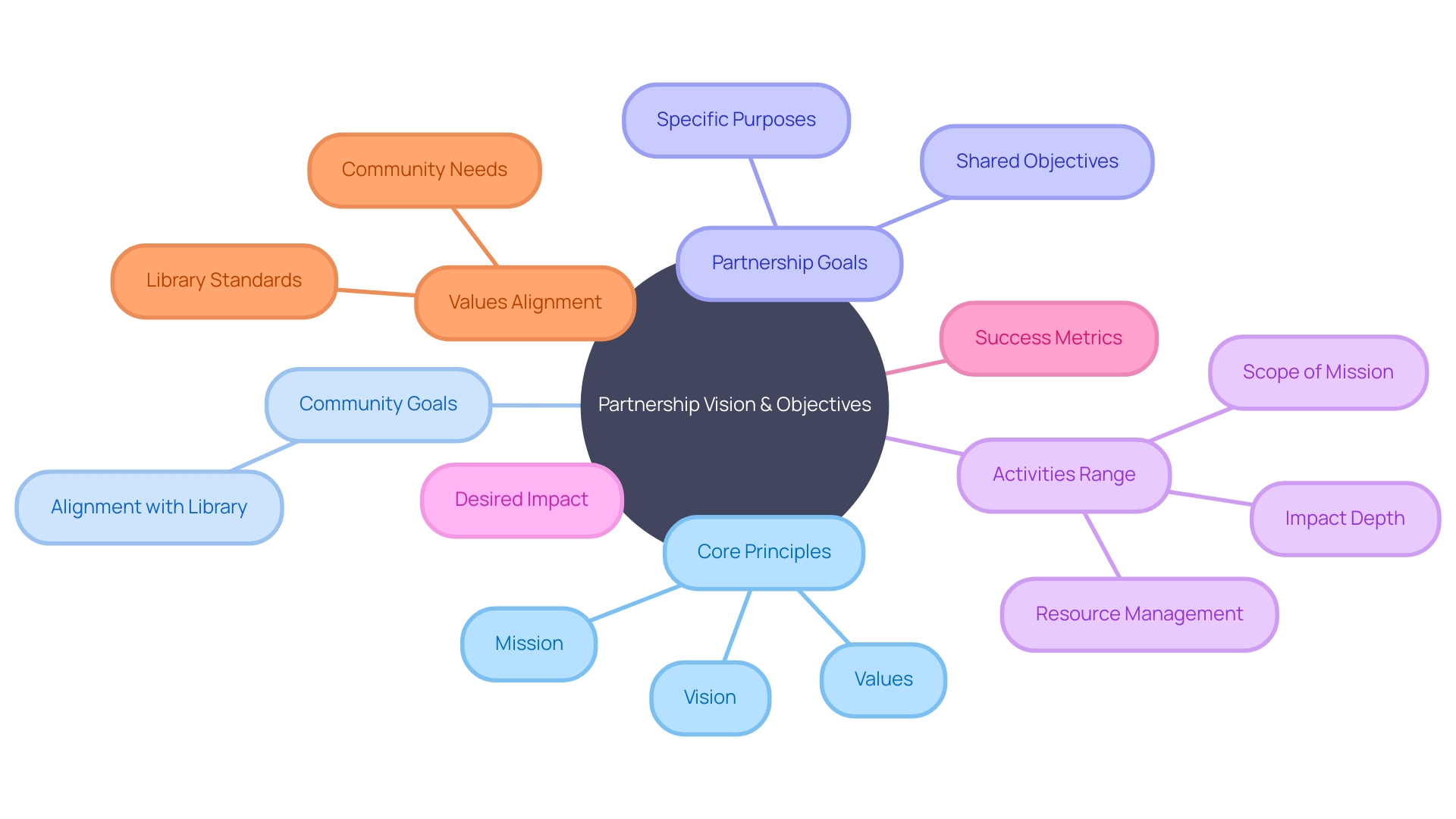
Establish Effective Communication Channels
The essence of MVP Software Development hinges on not just the practical coding skills, but significantly on the art of communication. Within the engineering teams, adherence to clear communication practices manifests in a variety of ways. For instance, software engineer Sergey Sviridov from JetThoughts highlights the importance of self-review and testing within a staging environment—methods that not only enhance the quality of code but also give transparent insights into a developer's workflow, thus building customer trust and streamlining management oversight.
In sync with the approach adopted by Sviridov, the technique of clear-cut API contract documentation—as learned from the Chick-fil-A Customer Technology team's initial challenges—can be pivotal. This requires well-documented contracts that are unambiguous, promoting seamless team interactions and avoiding the inefficiencies that befall poorly communicated API usage.
Echoing this sentiment, the TotalEnergies Digital Factory serves as a beacon for collaboration, having rapidly produced digital solutions through APIs that efficiently modernize legacy systems. Engaging in such practices signals TotalEnergies' commitment to driving their digital transition coherently and comprehensively.
Moreover, poorly executed communication cascades numerous negative repercussions, causing financial strains, as highlighted by the LLCBuddy editorial team. Further endorsed by the data collected from over 1,000 companies by Common Paper, well-defined contractual terms serve as the foundational bedrock for lucid interactions, impacting negotiations and partnership longevity.
From CEOs to developers, the underlying theme remains resonant—effective communication is the linchpin for successful collaboration and partnership in MVP Software Development, reflecting Guy Johnson's philosophy of finding a 'value exchange' over merely establishing common ground.
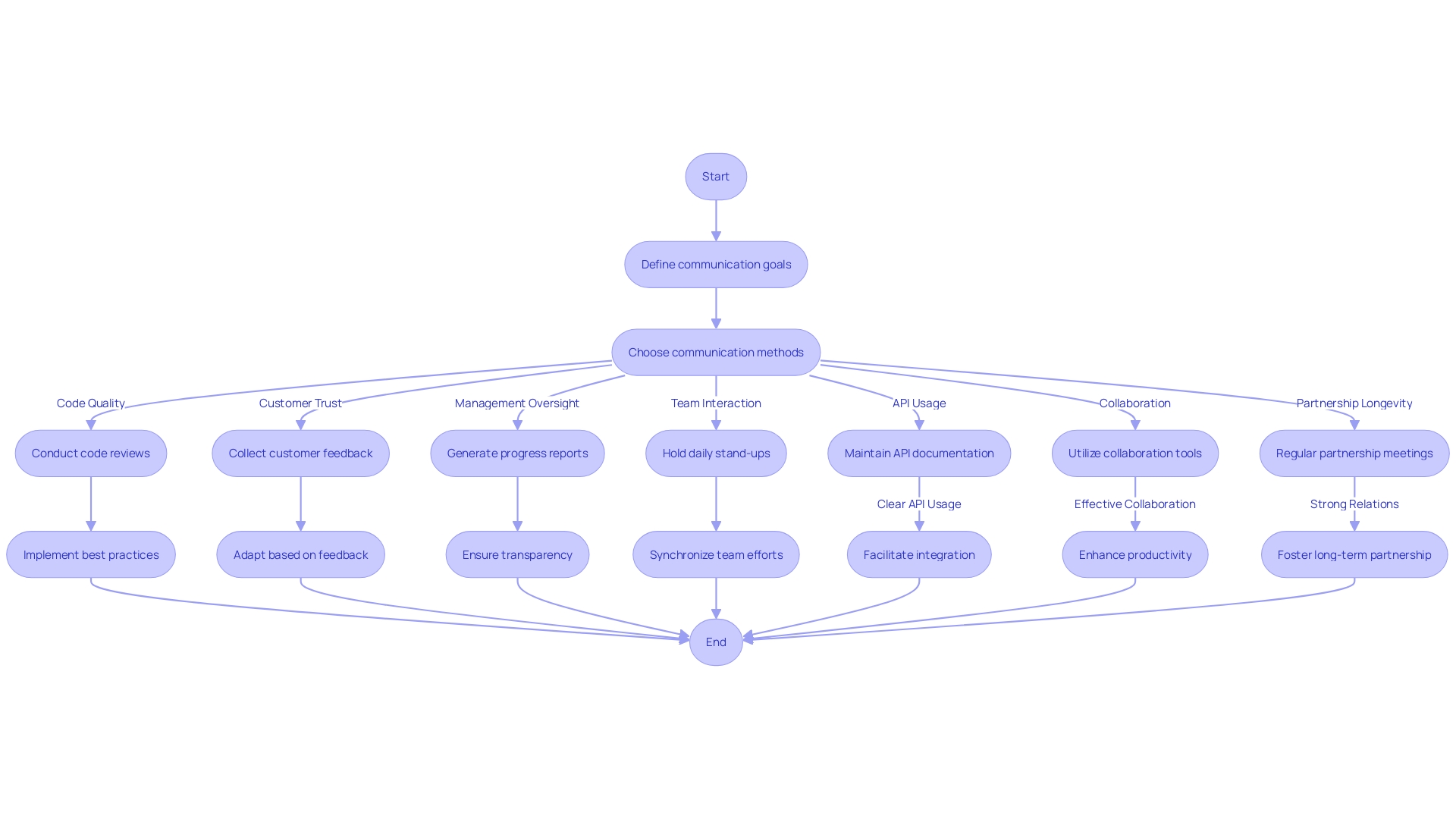
Collaborate on Technology Strategy
Integrating a strategic technology approach is key to powering business growth and achieving innovation. This proactive strategy, spearheaded by an astute Outsource CTO, involves pinpointing cutting-edge technology opportunities that resonate with the core business aspirations. It necessitates a keen evaluation of potential risks and the deployment of robust solutions to spearhead growth and foster innovation.
Drawing insights from collaborative endeavors, such as the one where a design system was crafted amidst a technology migration, the role of the CTO transcends traditional boundaries, championing scalability and the Component Driven Design methodology. The evolving dynamics of the CTO's role highlight the significance of engaging across varied profiles to overcome adversities, much like the narrative of heroes triumphing over villains in a classic tale.
A Chief Technology Officer's purview now extends beyond the realm of technology management into the strategic vanguard, driven by AI, cloud solutions, and IoT. Learning from past initiatives asserting that iterative approaches foster better outcomes, a CTO's foresight into emerging tech trends becomes indispensable. This forward-thinking approach, coupled with empirical evidence emphasizing the paramount importance of clear goal-setting and aligned expectations, solidifies the Outsource CTO's position as a linchpin in executing a vision that harmonizes with the overall trajectory of the enterprise.
As the nexus where innovation converges with business strategy, this role assumes the responsibility to propel the corporate ethos into a future of sustainable progress and distinction.
Ensure Knowledge Transfer
Implementing a strategy for transferring knowledge from an outsourced Chief Technology Officer (CTO) to an organization's internal team members is critical for long-term success. As the business world rapidly evolves with the integration of artificial intelligence (AI) and automation, executive forecasts suggest that up to 40% of the workforce will require reskilling in the next three years. To stay current and innovative, companies must embrace a culture of continuous learning and development.
Applied learning, which encompasses the informal transfer of skills through collaboration and real-life experience, is a core component of this knowledge sharing. Spotify, as an example, attributes much of its ingenuity and agility to its focus on both formal and informal learning processes. They recognize the significance of measuring the real-world impact of learning to ensure alignment with organizational objectives.
Fostering an environment where knowledge is readily exchanged not only prepares employees for the evolving demands of their roles but also mitigates risks associated with a low "bus factor," where an unforeseen event affecting key team members could jeopardize project stability. Valuable insights from seasoned experts, like those from industry experiences with SaaS reorganization, bring an added depth to applied learning, preparing teams for high-consequence business scenarios that are difficult to anticipate.
Devoting time to sharing knowledge and mentoring is not a mere luxury; it is a necessity for sustaining innovation and competitive edge as affirmed by the literature on open innovation. Empowering internal team members through targeted skill development can drive innovation more effectively than relying solely on external talent, which aligns with the observed trend of leading IT outsourcing firms reducing their workforce for the first time in decades. The knowledge transfer process contributes to preparing the company for the future while bolstering its technological capabilities.
Common Mistakes in Outsourcing Tech Teams
Outsourcing tech teams is a pivotal strategy for growth used by successful businesses worldwide. However, navigating this terrain can be tricky, and pitfalls abound if not handled with care and proper planning.
Outsourcing, as defined, involves engaging a third-party individual or organization to take on certain tasks or operations that may traditionally be handled internally. This approach can afford businesses increased efficiency and access to specialized skill sets, not to mention cost savings. Small businesses, in particular, can leverage outsourcing for a variety of functions – whether it's content creation, accounting, or customer support – to tap into expertise that may not be readily available in-house.
While the financial benefits are considerable, companies must pay equal attention to operational efficiency and quality output to ensure that outsourcing decisions truly align with business goals. A collaborative approach, often termed 'co-sourcing,' is gaining traction, blending internal and external resources for customer support and success.
The tech industry displays a keen penchant for outsourcing, with variations ranging from complete project handover to selective task delegation. One remarkable approach from a small team at Sym demonstrates the effectiveness of concise project briefs followed by rapid and robust development, epitomizing the agility that outsourcing can offer.
Despite these benefits, many companies encounter hurdles. A narrative from a front-end developer illustrates a scenario where companies transition from in-house written brownfield products to outsourced solutions. This transition is riddled with technical and management challenges as they shift to greenfield projects.
Industry news underscores the importance of finding the right outsourcing partner who aligns with the company's vision and can adapt to business changes, especially during growth phases. Flexibility, omnichannel support, and cultural alignment are critical factors to consider.
The narrative of the Dutch Parliament outsourcing email management and the “.NL” domain management underlines the delicate decision-making process that crosses international borders, emphasizing that size and technological capability are substantial factors influencing the outsourcing debate.
Yet, it is imperative to remember, as expressed by those in the tech consulting field, that companies typically seek outsourcing not when things are going perfectly, but rather when challenges loom large. And the software technology sector is no stranger to such challenges, facing a global shortage of developers projected to worsen significantly.
Outsourcing strategies must be carefully orchestrated; it is not just about finding a team to take over tasks but discovering the right collaboration that elevates efficiency and catalyzes growth without compromising the ethos and dynamic of the established in-house team. By understanding these essential elements of outsourcing, businesses can adeptly avoid the common mistakes and realize the full potential of their tech team collaborations.
Lack of Clear Communication
Clear, concise, and prompt communication plays a pivotal role in the outsourcing ecosystem. Vague instructions and unspoken assumptions can spiral into costly delays and diminished project outcomes. For instance, consider the incident following Ronald Reagan's death, where a lack of decisive communication resulted in a critical financial report going unchecked due to an unexpected federal holiday.
This exemplifies how crucial it is to define and communicate plans or changes in a timely manner.
Similarly, the principle of directness, akin to the swift removal of a Band-Aid, holds weight in the corporate world. A straightforward approach to delivering difficult news can cultivate respect and appreciation among stakeholders, rather than allowing issues to fester and erode trust.
This ethos of transparency and clarity is fundamentally tied to the success of digital transformations within supply chains. Common pitfalls often stem from data siloing, resistance to change, and unclear messaging regarding the advantages of new initiatives. An effective strategy to navigate these challenges includes collaborating with leadership to articulate an engaging vision and openly communicating the transformation’s benefits to address every stakeholder's concerns.
Anecdotes from industry experiences echo this sentiment. Adi Klevit of the Business Success Consulting Group underscores the difficulty entrepreneurs face in entrusting tasks to others, which often reveals underlying communication deficits, such as a reliance on unspoken knowledge rather than well-documented processes.
Furthermore, understanding the impact of outsourcing is crucial for IT professionals, particularly as globalization makes this practice increasingly prevalent. Press releases, like those from Gofaizen & Sherle, and analyses of outsourcing trends underscore the necessity for businesses to articulate their goals, expectations, and the strategic relevance of their pursuits with external partners.
Effective communication sets the tone for a thriving work culture that promotes innovation and cooperation. By reinforcing this core tenet, organizations stand to amplify efficiency and navigate the treacherous waters of outsourcing and digital transformation successfully.
Lack of Proper Due Diligence
The careful selection of an outsourcing partner is paramount for successful project execution. It's not just about cost savings; it's also about technical prowess, reliability, and the synchronicity with business goals. Consider the cautionary tale of a premier German finance house venturing into the cryptocurrency space.
The challenges of compliance and anti-money laundering (AML) required not only a vendor with expertise but also one that offered ongoing collaboration and data insights. Chainalysis was chosen because they provided more than AML solutions; they brought to the table a partnership that was instrumental for navigating the complexities of the crypto market.
Before committing to a software development agency, detailed scrutiny of their previous projects can offer valuable insights into their technical capabilities. In other words, don't be swayed by the promise of low-cost services alone. The true cost of software development encompasses more than just the hourly rate you pay.
It includes the effort involved in communication, management, and the unseen expenses of maintenance and stability, both during and after the project's lifecycle.
Seek vendors whose work is thoroughly documented, offering robust automated testing to reduce defects in future modifications. The presence of senior engineers and technical certifications is indicative of skill. Moreover, the transition of knowledge back to your in-house team should be a key consideration.
As Eddie Kim of Gusto aptly said, giving your most difficult problems to capable developers can minimize long-term maintenance costs and, ultimately, deliver higher quality software.
When exploring potential partnerships, don't hesitate to reach out to former clients for references, evaluate the vendor's domain experience, and ensure they have a track record of adhering to timelines and budgets. All these factors play a crucial role in identifying an outsourcing partner that not only promises but also delivers value, quality, and stability, aligning with your business growth trajectory.
Ignoring Cultural Differences
Navigating cultural disparities is a cornerstone for the success of international business ventures. It's about more than recognizing diversity—it's about harnessing it to foster genuine collaboration and sustain positive relationships. Take, for instance, Nets, the Copenhagen-based digital payment solutions giant.
They've maneuvered through intricate cultural fabrics to present technical data in engaging ways that resonate across borders. Their initiative to reframe complex tables into digestible, motivating formats exemplifies mindful cultural translation in business practices.
Understanding the impact of culture extends beyond borders. The Forbes Councils Member advocates for tailoring business approaches to align with local customs, revealing that what succeeds in one region may falter in another due to varying cultural expectations. Such knowledge is integral to cultivating strong customer relationships and ensuring the seamless operation of your organization globally.
Moreover, the six core elements of the relationship code—place, power, purpose, privacy, presence, and pacing—underscore the nuances of international collaboration. It can be as specific as where relationship building thrives: in a karaoke bar in Japan versus the general workspace in Canada. Recognizing these differences allows global teams to engage effectively, making every interaction count.
Lastly, the economic implications of ignoring cultural nuances can be profound. A study highlighted that a wealth of cultural experience contributes to better mental health and creativity among children. In a broader economic context, understanding and integrating cultural richness could be the key to breaking the cycle of cultural prejudices and economic disparities.
Investing in the integration of cultural awareness, then, becomes more than a strategic move; it's a commitment to corporate growth, innovation, and a more inclusive global market space.
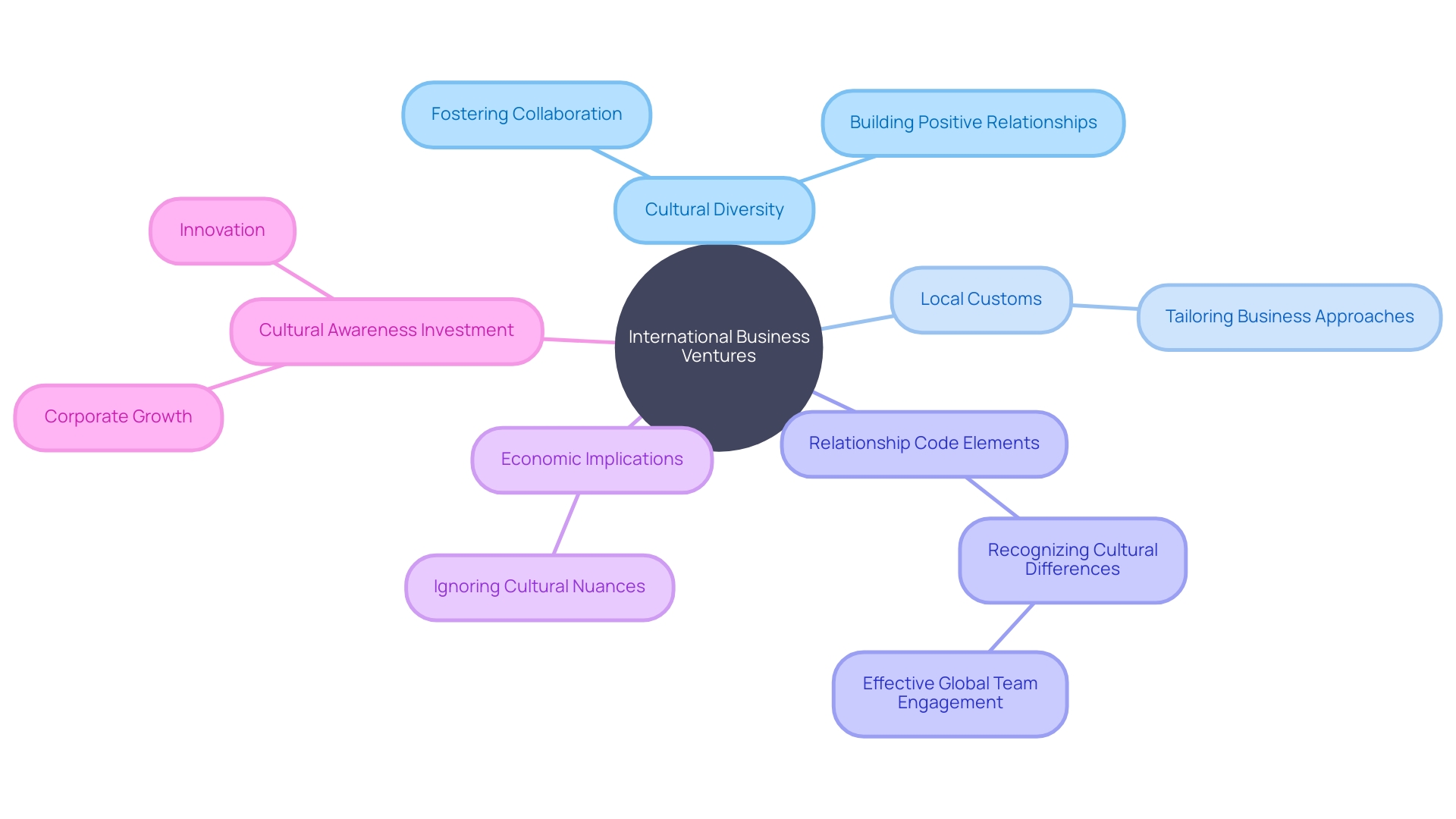
Case Studies: Successful Outsourced CTO Engagements
The transformative power of outsourcing the role of a CTO can be gleaned from numerous case studies, which highlight how businesses utilize external technology expertise to foster growth and advance their technological agendas. For instance, the journey of Prashant Varanasi, who transitioned from a high school coding enthusiast in Australia to a Silicon Valley professional, underpins the value of strategic technology guidance in driving career success and innovation. His early exposure to coding, paired with real-world applications like programming competitions, set the foundation for a career in tech, eventually leading to scholarships and further educational opportunities.
The importance of having an Outsource CTO is further enforced by the ever-expanding role of technology in every business sector. Today's CTO goes beyond routine maintenance; they are integral to steering companies through the digital transformation landscape, making critical decisions that align with employee needs and customer benefits. For example, a retailer that can seek expertise from an Outsource CTO might avoid pitfalls like hastily deploying insecure online systems, which can lead to breaches and loss of customers' trust.
Moreover, outsourcing is about strategically augmenting your business capabilities, as illustrated by companies that co-source customer support and success functions. The flexibility to tap into a global talent pool—whether it's to bolster customer service, utilize advanced technologies, or navigate the blank whiteboard problem that many engineers face when starting from scratch—is a testament to the value of an Outsource CTO. These professionals bring a wealth of diverse experience, having often dealt with the bottleneck of limited experience within their prior roles, and are adept at engineering solutions that balance multiple requirements and inputs.
As businesses look toward the future, the role of the CTO is seen as increasingly strategic. By 2024, CTOs are expected to be key drivers of innovation, immersed in emerging tech trends, and involved in top-tier strategic decision-making. In this climate, organizations that align their technology strategies with overarching business objectives stand to gain the most—a principle that an experienced outsourced CTO inherently understands and effectively applies.
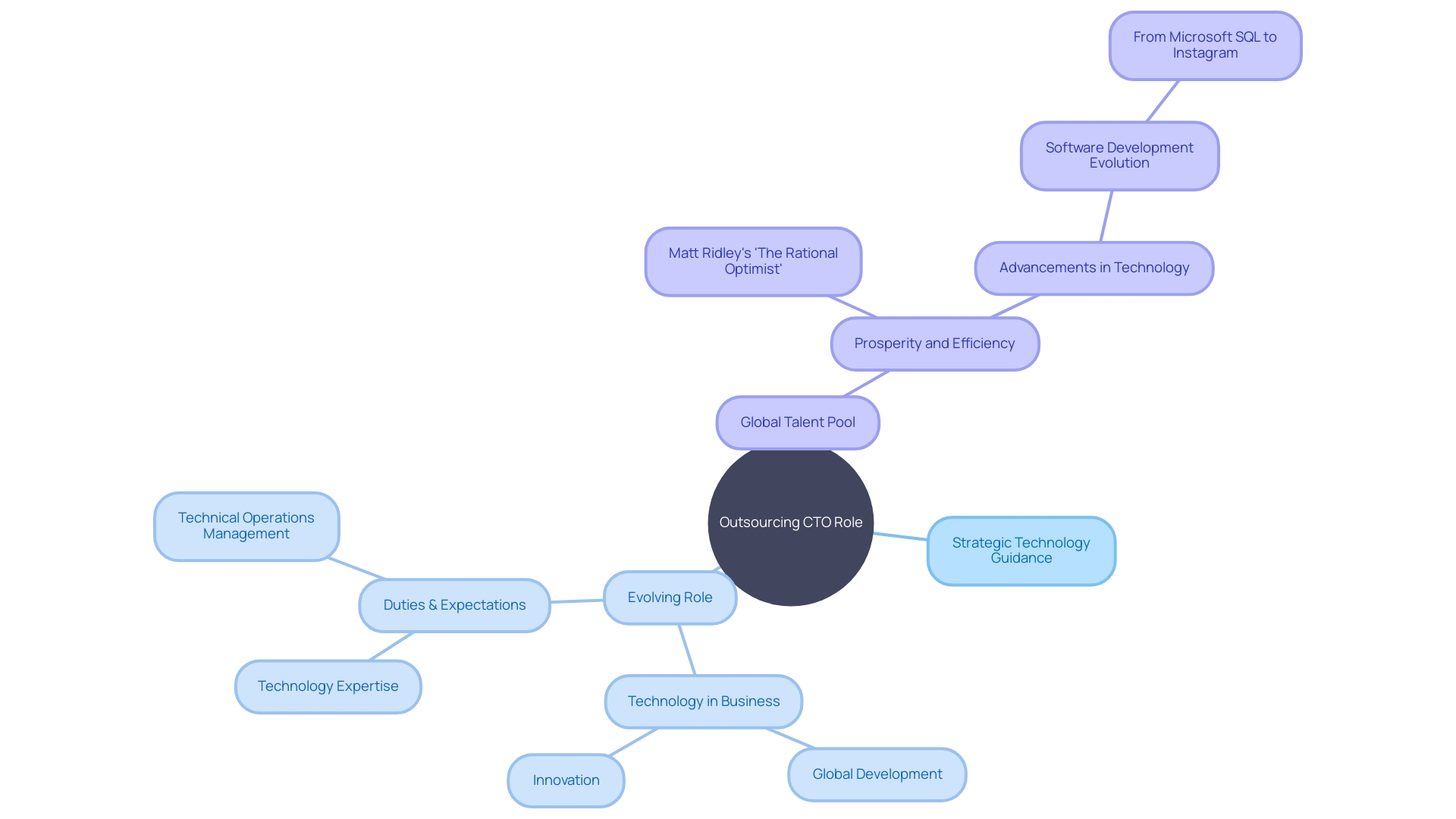
How to Hire the Right Outsource CTO
Selecting an Outsource CTO is a pivotal decision that can shape the technological trajectory of a company. It involves more than just skimming through resumes; it requires a strategic approach tailored to the evolving demands of today's tech landscape. To tap into the full potential of AI, cloud computing, Machine Learning, and IoT, businesses must find a CTO who can not only manage technology but also drive innovation and partake in executive-level strategic decisions.
An example of this growth in responsibility can be observed in the career journey of an individual who went from coding competitions in Australia to strategic technology roles in Silicon Valley, demonstrating that a strong foundation in technology can lead to influential leadership positions. As tech roles diversify, candidates need not only to exhibit technical acuity but also strategic vision and the ability to withstand rapid organizational growth, where teams can double in size annually after product-market fit is achieved. With the majority of startup employees having less than two years at a company, a CTO must be adept in rapidly integrating into the culture and managing a team where half the staff may be relatively new.
This person will not only align with the immediate objectives but will also confidently navigate through the surges of change that lie ahead.
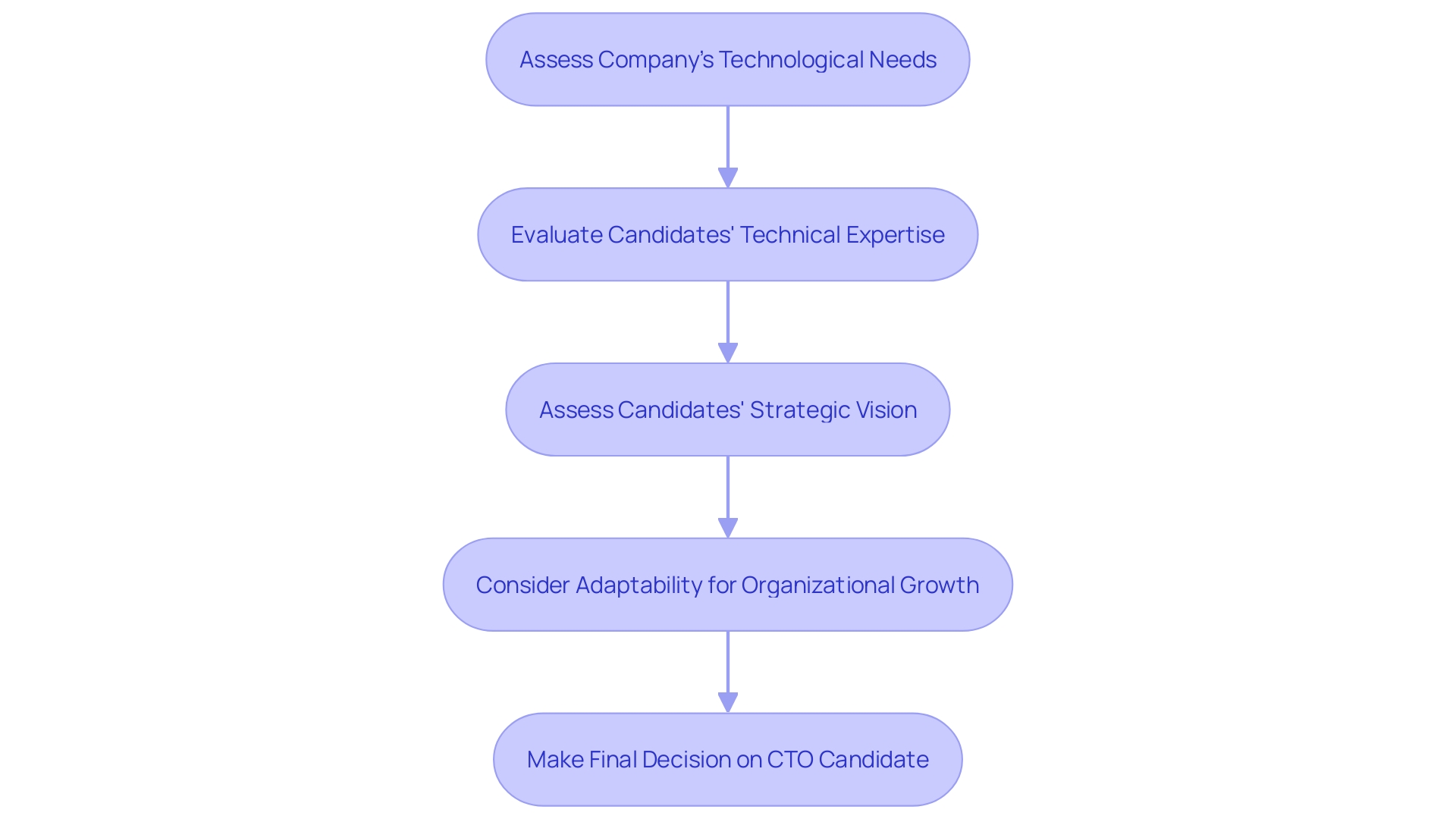
Define Your Requirements
Optimizing the skill set and the technological adeptness of your Outsource CTO is essential for driving your business towards success. As the digital marketplace expands, so do the possibilities for strategic innovation; thus, identifying candidates who not only align with but can elevate your unique technological requirements is crucial.
According to findings from TotalEnergies Digital Factory's operations, tailored digital solutions can significantly aid an organization's progression. For example, in implementing over 80 specialized software deployments across 25 countries, they highlighted the critical nature of API integration in modernizing information systems. Similarly, Lindy's pursuit to enhance their AI assistance platform through broad application integrations underscored the necessity of technical excellence in a CTO to lead such challenging digital transformations.
In light of recent changes in the role of a CTO, as businesses swiftly incorporate AI and cloud computing technologies, it's imperative that your Outsource CTO is not only a technical expert but also a strategic visionary. One who is adept at navigating the evolving landscape of technology and capable of integrating emerging trends to maintain a competitive edge. As mentioned in industry insights, the modern CTO is expected to be a core part of strategic decision-making, wielding a profound understanding of analytics and its applied potential within business processes.
Statistics further reinforce the need for comprehensive tech skills in addressing global challenges and advancing business objectives. With software and information security skills seen as a bottleneck in crucial areas, it's evident your Outsource CTO should have a commanding grasp of these competencies to lead initiatives effectively.
Leveraging this complex blend of strategic insight, technological proficiency, and innovation, your selected Outsource CTO could be the key to ensuring not only that your technology aligns with current company strategies but that it's also future-proof, ready to tackle emerging challenges and leverage opportunities for growth.
Research and Evaluate Candidates
Selecting a software developer is a multifaceted process that involves digging deeper into their professional background and coding prowess. You must carefully examine their prior achievements, confirming they can translate technical requirements into robust solutions. Review samples of their work and delve into case studies, which serve as concrete evidence of their expertise and problem-solving capabilities.
A comprehensive approach to evaluating developers extends beyond credentials. Consider their practical experience, particularly their fluency in key programming languages such as JavaScript, Python, or Java, and their adherence to coding standards. This ensures that your product will be built with maintainable and scalable code.
Statistics emphasize the urgency of effective hiring practices. With a looming 1.4 million tech job vacancies and an annual introduction of 344K new tech roles, securing the right talent becomes imperative for continued innovation and growth in the tech industry. Additionally, case studies, such as those in data analysis, offer valuable insights into a developer's ability to navigate complex tasks from data cleaning to visualization, underlining the importance of a multifaceted skill set.
In seeking candidates, McKinsey acknowledges that while software development is 'perennially undermeasured', it's vital for non-engineering executives to understand the evolving nature of the field to effectively assess and improve developer productivity. Identifying developers who align with this perspective and possess a practical, problem-solving mindset, as echoed by industry professionals, will be crucial for your startup's success in this competitive landscape.
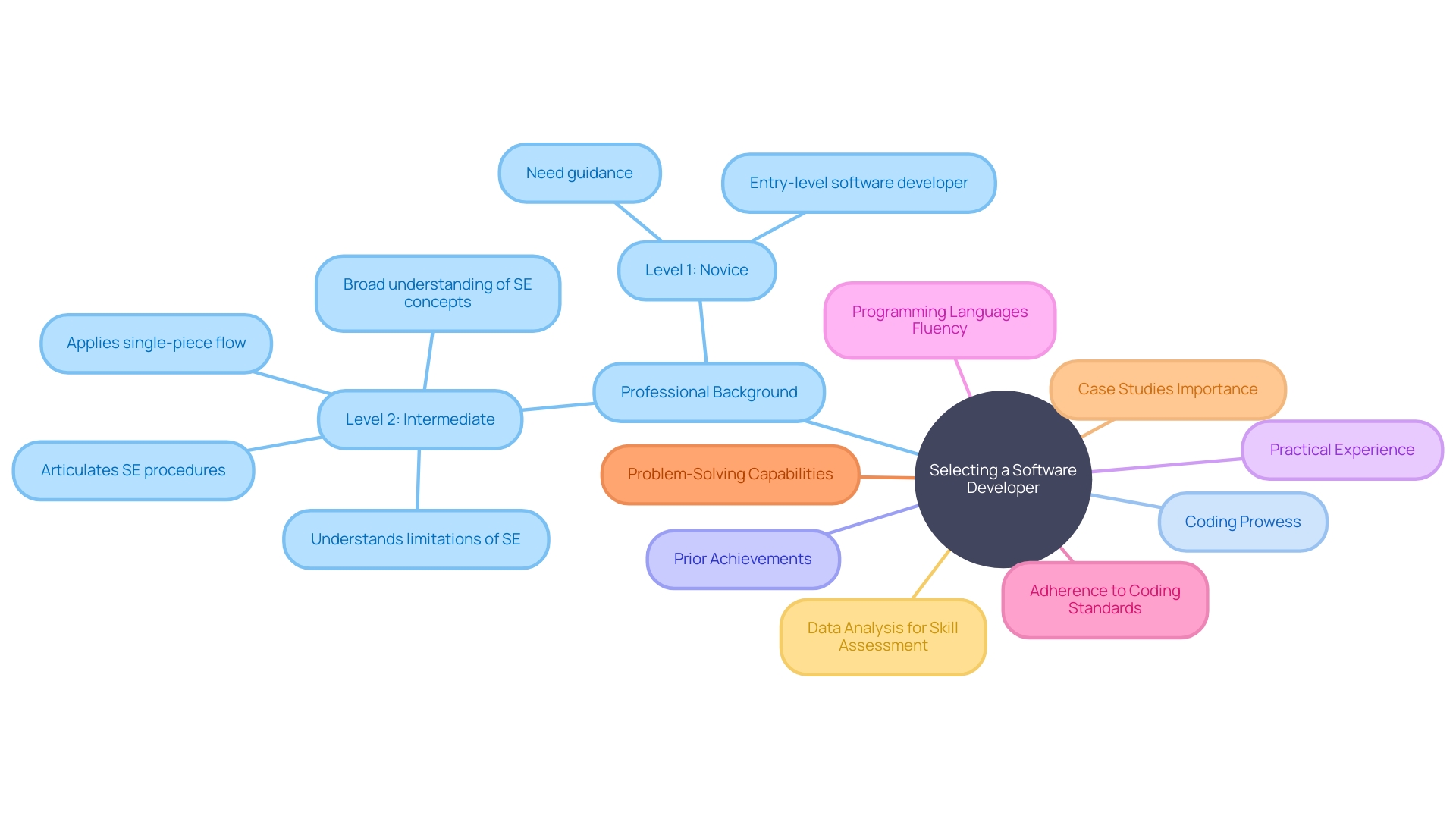
Interview and Assess
To optimize your talent acquisition, pushing beyond basic interview questions and truly evaluating a candidate's compatibility with your company's ethos is essential. It's vital to perceive the interview not just as a formality but as a foundational step to secure future leaders who align with your organizational values and objectives. Incorporate questions that cut to the core of an applicant's problem-solving prowess and technical aptitude, while also digging deeper to comprehend their approach to ongoing learning and adaptation in a tech landscape that is perpetually evolving.
Remember, the caliber of your questions is a direct reflection on the quality of talent you attract and retain. Embrace this as an opportunity to distinguish those who don't just code, but think critically and contribute meaningfully to your company's mission.
Agree on Terms and Expectations
*After choosing your ideal software partner, it's critical to crystalize the engagement terms. Define the project's scope, deadlines, and concrete outcomes expected. Clarify the project's aims and ensure a mutual understanding of the expected results.
Release dates mark the readiness to offer novel customer experiences across all interaction points, while features – the slices of functionality within releases – and requirements – the detailed capabilities needed for features – outline the 'what' and 'when' of the project. *
*Review the vendor's project history to judge their expertise. Don't just take their healthcare industry experience claims at face value; verify through references. Evaluate their team's technical proficiency, certifications, and industry-specific knowledge – the latter is imperative in sectors like healthcare with distinct needs.
Remember, a team's approach to communication, their shared vernacular or jargon, facilitates timely and effective project execution. *
*Software estimation is notoriously difficult, as analogous experiences seldom apply due to the uniqueness of software solutions. Even proficient estimators may struggle, underlining the importance of feedback-driven agile development methods. Before collaboration, establish your business objectives.
Initiate joint workshops with the software partner to grasp challenges and devise fitting solutions, and furnish them with detailed RFI documents that encapsulate your requirements. *
*Finally, ponder on the model of cooperation that befits your organization. The end-to-end model, for example, involves the software partner completely overseeing the development journey, offering a likely advantage of cost certainty and comprehensive solution ownership. *
Conclusion
In conclusion, outsourcing a Chief Technology Officer (CTO) offers businesses strategic technical expertise, driving growth through custom technology strategies. The benefits include cost savings, access to top talent, flexibility, and an objective perspective. However, successful partnerships require clear communication, due diligence, and understanding of cultural differences.
Hiring the right Outsource CTO involves defining requirements, researching candidates, conducting thorough interviews, and setting clear expectations. By partnering with an Outsource CTO, businesses can drive innovation and growth in today's dynamic tech-driven marketplace.
Effective communication is crucial in outsourcing, fostering transparency and collaboration. Creating clear communication channels ensures efficient project execution.
Collaborating on technology strategy is essential for business growth and maintaining a competitive edge. Outsourced CTOs identify cutting-edge opportunities, evaluate risks, and deploy robust solutions.
Knowledge transfer from the outsourced CTO to the internal team is vital for long-term success. Emphasizing a culture of continuous learning prepares teams for evolving demands and mitigates risks associated with key team members leaving.
Avoiding common mistakes such as clear communication, proper due diligence, and cultural understanding is key in successful outsourcing relationships.
In summary, hiring the right Outsource CTO involves defining requirements, researching candidates, effective communication, collaboration on technology strategy, and knowledge transfer. By following these best practices, businesses can build productive partnerships that accelerate growth and innovation.





